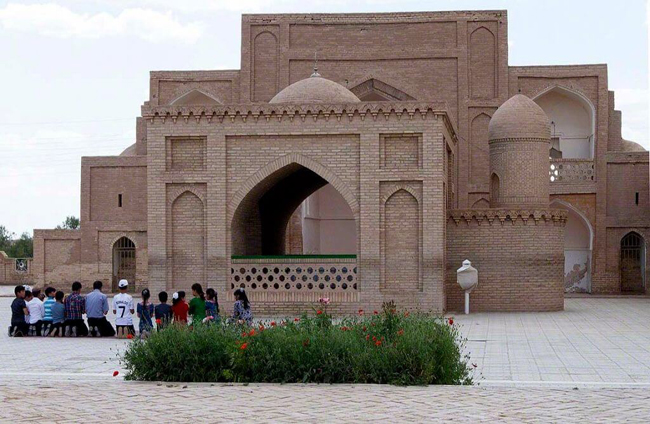-

 Know, the true nature of your Beloved.
Know, the true nature of your Beloved.
In His loving eyes, your every thought,
Word and movement is always –
Always Beautiful.
~ Hafiz
The Golden Chain

9. Khwaja Yusef al-Hamadani
Khwaja Abu Yaqub Yusef al-Hamadani (may God sanctify his innermost being) is the ninth Sheikh in the Naqshbandi Golden Chain and is also the first of the ‘Khwajagan’ – the Masters of Wisdom of Central Asia. He was born in 1048 AD in Buzanjird, near Hamadan, in present day Iran.
He travelled to Baghdad at eighteen years of age to be taught by the greatest Islamic scholars of his time, including the master of his time, Shaykh Ibrahim ibn Ali ibn Yusef al-Firuzabadi. When he arrived, Shaykh Ibrahim sat the young Yusef in front of him, where he learned Islamic jurisprudence. His other teachers included Abu Ishaq ash-Shirazi, Abul-Hussain Muhammad ibn Ali, Abul-Ghana’im Abd al-Samad ibn Ali ibn Mamun, Abu Jafar Muhammad ibn Ahmad ibn Muhammad, Khatib Baghdadi and many others.
He then studied Hadith, Tafsir, Fiqh and Philosophy in Isfahan and Bukhara under other prominent teachers. Although many of his teachers were Shafi, he followed the Hanafi school. He became a brilliant jurisprudent and the most knowledgeable reference for the scholars of that time.
His training in the spiritual or mystical heart of Islam, Sufism, was also of the highest order. His Masters were Shaykh Hasan Simani, Abdullah Juwayni and his final teacher who gave him his spiritual secret was Shaykh Abu Ali al-Farmadi, the eighth Shaykh of the Naqshbandi Golden Chain. Khwaja Yusef al-Hamadani was the ‘Ghawth’ or Master of his time in raising the station of his followers, with some scholars considering him to be the Mujaddid of the sixth century instead of Imam Gazzali.
He was well known throughout the Islamic world, including Baghdad, Isfahan, Bukhara, Samarqand, Khorasan and throughout Central Asia. After his training, he returned to Hamadan to teach. Soon afterwards, he received invitations from a number of the centres of Islamic culture in Central Asia, including Merv, Bukhara and Herat. In 1080, Khwaja Yusef and some of his followers moved to Bukhara. He then lived in Merv in Turkmenistan, travelling at times to Herat in Afghanistan. He spent sixty years of his life teaching and providing both esoteric and exoteric spiritual guidance. His extraordinary knowledge brought large numbers of seekers, scholars and pious people to his Centre in Merv, to listen to his teaching. Samani related that no other Centre received so many seekers as Khwaja Yusef – it was called the ‘Kaaba of Khorosan’.
In Ramadan of 1111 AD, Sultan Sanjar, the leader of the of the Great Seljuk Empire, sent fifty thousand gold coins from Samarqand to Khwaja Yusef for his teaching Centre. Khwaja Yusef did not take anything of the gifts given to him for his personal use.
He was described as,”cheerful, considerate, gentle and compassionate”. He lived as a poor man (although given great wealth by some of the rulers of the time), by the work of his own hands. During the sixty years that he taught, Khwaja Yusef remained among the people, teaching to all people without discrimination. Through him countless miraculous events occurred. His teaching were firmly based on the Quran and the Sunnah of the Prophet (peace & blessing upon him). He inherited the turban and walking staff of Salman al-Farsi, the third Shaykh of the Naqshbandi Golden Chain, which came to him through Zain al-Abidin.
Being the ultimate Shaykh and spiritual mentor, Khwaja Yusef had a profound influence on world history and its spirituality. His deputies continued the Naqshbandi and Khwajagan tradition, founded the Yasaviyyah and Bektashiyyah Tariquats and the founders of the Qadri and Chisti orders also benefited from his teaching.
He was the Shaykh of:-
– Khwaja Abdul Khaliq al-Ghujdawani, the eleventh Shaykh in the Naqshbandi Chain (to be found in the ‘Golden Chain’ section).
– Khwaja Ahmed Yasavi:- the founder of the Yasavi Order and link to Hajji Bektashi, who founded the Bektashi order, he exerted a powerful influence on the development of Sufi orders from Constantinople to China. Following Khwaja Yusef’s advice, he advised his students to follow Khwaja Abdul Khaliq before he left to spread Islam and Sufism in Turkestan. His poetry created a new genre of religious folk poetry in Central Asian literature, inspiring many religious poets that followed him.
Refer to the Sufi Poetry section for Poetry by Khwaja Ahmed Yasavi.
– Khwaja Abdullah Khwarizimi
– Khwaja Hasan Andaqi:- he had special and effective techniques for training his disciples. By following the example of the Prophet (peace & blessings upon him), he attained a high degree of purity.
Other Saints that visited Khwaja Yusef were:
– Abdul Qadir Gilani, the great Shaykh who founded the Qadri order.
– Hakim Sani, the great Naqshbandi Shaykh.
Later in his life, Khwaja Yusef secluded himself, becoming engaged in constant worship and spiritual struggle. He died on a journey from Herat to Merv in 1140 AD, at ninety two years of age. He is buried in Merv, Turkmenistan, where a mosque and large school has been built beside his grave, being a place of pilgrimage for spiritual seekers.
Khwaja Yusef al-Hamadani’s fourth and greatest successor was Khwaja Abdul Khaliq al-Ghujdawani, to whom he passed the secret of the Naqshbandi Chain.
May God be well pleased with him.
Sources:- ‘The Naqshbandi Way – History and Guidebook of the Saints of the Golden Chain’ by Mawlana Shaykh Hisham.
‘Rashahat Ain al-Hayat – Beads of Dew from the Source of Life. Histories of the Khwajagan The Masters of Wisdom’ by Mawlana Ali ibn Husain Safi.
‘Masters of Wisdom of Central Asia’ by Hasan Shushud.
‘The Masters of Wisdom’ by John G. Bennett.
